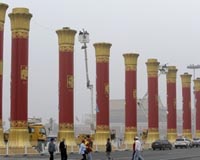 |
Shanghai (AFP) Sept 27, 2009 Charlie Chaplin traipsed through its halls, Noel Coward finished his play "Private Lives" there and owner Victor Sassoon threw lavish parties for Shanghai's high-rollers. The Peace Hotel burned bright in the 1930s, but war, revolution and ill-conceived renovations battered the Bund institution and what was once the most luxurious hotel in the Far East faded into a shadow of its former self. Now architects and historians are scrambling to complete a 500-million-yuan (73-million-dollar) renovation of the Shanghai landmark in time for next year's World Expo, combining ultra-modern comforts with the hotel's colourful past. "We thought it was going to be a fairly straightforward restoration project. It didn't turn into that," said Ian Carr, head of the team from Hirsch Bedner Associates, known for restoring architectural gems such as London's Savoy. "The problem for us was there was no way of telling what was original and what was artifice -- and when did it change?" The heyday of the Art Deco hotel, then known as the Cathay, ended in August 1937 when two Japanese bombs exploded outside its doors. It remained open until 1941, when Japanese forces occupied the city. The drama of World War II eventually gave way to civil war -- with Nationalist and Communist troops commandeering the building at various points. The famed building reopened in 1956 for visiting Soviet delegations as the Peace Hotel. But key parts of its original fittings were destroyed or covered up in the intervening years. During the Cultural Revolution, employees hastily threw up new ceilings to hide imperial symbols from rampaging Red Guards. In the 1980s, marble fixtures were removed in an attempt to "freshen up" the hotel. The countless reincarnations, paired with the loss of many of the original furnishings, sold off in Shanghai's back allies, left Carr and his team with a difficult task -- how to restore the hotel to its past glory. "It was hard to find anything that was a solid lead," he said. The designers contacted the original 1929 architects, Palmer and Turner, tracked down the Sassoon family in the Bahamas and even advertised in Shanghai newspapers seeking anyone with information. Almost nothing turned up, and some experts say the lack of records makes restoring the hotel an impossible -- and pointless -- task. "Modern people have different taste ... I'm very sceptical of the assumption that tourists would love the style of the 1920s," said Lu Jiansong, a professor of cultural heritage at Shanghai's Fudan University. But historian Peter Hibbard disagrees. He joined the project, bringing numerous photos, 1930s newspaper clippings and rare film footage of the hotel, which offered clues about the stylish Art Deco furnishings. "This city can fool everybody. It's so difficult to know what's fake, what's old, what's new. It's a total mystery," Hibbard said. But Carr's team was caught between the conflicting visions of the hotel's new management, Fairmont Hotels and Resorts, its owners, the Shanghai government-controlled Jinjiang Group and heritage authorities, he said. "We had Fairmont wanting a more fresh approach, we had Jinjiang wanting a more Victorian approach and we had the relics people wanting to have their say," Carr said. They also discovered a difficult guest who refused to check out. China Telecom said it would not leave its second-floor offices, and also insisted nothing could penetrate their floor -- forcing architects to work around the small, antiquated elevators. But a major breakthrough came in the form of a 1920s floor plan that helped the design team restore the hotel's rooms to their original dimensions. "They had been changed over the years and the room module had been very contorted -- bathrooms had been put up against windows. It was all very weird," Carr said. The designers have built an addition to the side of the hotel, fulfilling Sassoon's original vision and allowing them to bypass China Telecom to provide much needed modernisations. "This hotel never worked efficiently and effectively," Carr said. "Waiters were serving through guest corridors -- it was completely screwed up." The new centrepiece of the hotel will be the lobby topped by a rotunda with skylights, which had been covered up over the years. Lalique crystal lights and bronze balustrades have been restored, and lost features like the Russian futurist murals in the lounge have been reproduced. "We're going to try to create a Deco-inspired destination -- rich and luxurious, sultry and very atmospheric," Carr said. Fairmont has said the Peace Hotel will reopen in time for the six-month World Expo, which begins on May 1. Share This Article With Planet Earth
Related Links China News from SinoDaily.com
 Excitement, irritation as China readies for National Day
Excitement, irritation as China readies for National DayBeijing (AFP) Sept 27, 2009 Liu Tongbo trudged through Beijing looking for transport as the city centre shut down to make way for an unusual sight -- a stream of colourful floats, student performers... and missile-laden vehicles. "I live in the suburbs but the tube isn't stopping in the city centre where I work, so I've been walking for 30 minutes," the 45-year-old businessman said as the capital launched its final ... read more |
|
| The content herein, unless otherwise known to be public domain, are Copyright 1995-2009 - SpaceDaily. AFP and UPI Wire Stories are copyright Agence France-Presse and United Press International. ESA Portal Reports are copyright European Space Agency. All NASA sourced material is public domain. Additional copyrights may apply in whole or part to other bona fide parties. Advertising does not imply endorsement,agreement or approval of any opinions, statements or information provided by SpaceDaily on any Web page published or hosted by SpaceDaily. Privacy Statement |